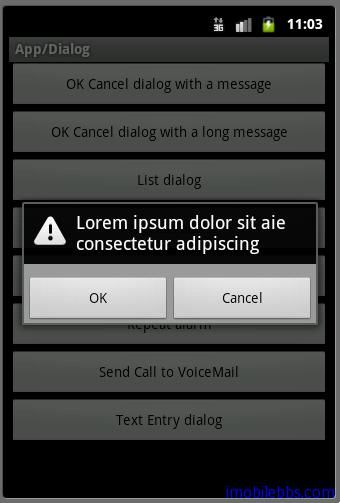【起航计划 020】2015 起航计划 Android APIDemo的魔鬼步伐 19 App->Dialog Dialog样式
这个例子的主Activity定义在AlertDialogSamples.java 主要用来介绍类AlertDialog的用法,AlertDialog提供的功能是多样的:
- 显示消息给用户,并可提供一到三个按钮(OK, Cancel ,Yes ,No)用于选择或是显示警告。
- 显示一个列表以供用户选择,列表中可以是Radio Button (单选),Check button (多选)
- 显示文本框来接受用户输入等。
创建AlertDialog一般是通过AlertDialog.Builder来构造:
AlertDialog.Builder ad=new AlertDialog.Builder(context);
之后可以为这个AlergDialog设置标题,显示的信息,需要显示的Buttons等。然后调用 ad.show来显示这个对话框。
为了避免每次显示对话框都新建一个Dialog对象,Android提供两个方法 onCreateDialog和onPrepareDialog事件来管理对话框的创建。
通过重载onCreateDialog,可以根据需要(如执行showDialog时)创建所需对话框实例。而在创建这个对话框实例后,在每次 showDialog之前,如果需要对这个对话框做些修改可以重载onPrepareDialog方法来实现。 原理和Android管理Menu的方法类似。
下面给出使用AlertDialog的一般步骤。因为在onCreateDialog可能创建多个Dialog示例,所以必须先定义一个Dialog的ID。
private static final int DIALOG_YES_NO_MESSAGE = 1; private static final int DIALOG_YES_NO_LONG_MESSAGE = 2; private static final int DIALOG_LIST = 3; private static final int DIALOG_PROGRESS = 4; private static final int DIALOG_SINGLE_CHOICE = 5; private static final int DIALOG_MULTIPLE_CHOICE = 6; private static final int DIALOG_TEXT_ENTRY = 7; private static final int DIALOG_MULTIPLE_CHOICE_CURSOR = 8; private static final int DIALOG_YES_NO_ULTRA_LONG_MESSAGE = 9; private static final int DIALOG_YES_NO_OLD_SCHOOL_MESSAGE = 10; private static final int DIALOG_YES_NO_HOLO_LIGHT_MESSAGE = 11; private static final int DIALOG_YES_NO_DEFAULT_LIGHT_MESSAGE = 12; private static final int DIALOG_YES_NO_DEFAULT_DARK_MESSAGE = 13; private static final int DIALOG_PROGRESS_SPINNER = 14;
然后重载onCreateDialog,参数id为Dialog ID,可以根据id来创建需要的Dialog实例:
@Override protected Dialog onCreateDialog(int id) { switch (id) { case DIALOG_YES_NO_MESSAGE: return new AlertDialog.Builder(AlertDialogSamples.this) .setIcon(R.drawable.alert_dialog_icon) .setTitle(R.string.alert_dialog_two_buttons_title) .setPositiveButton(R.string.alert_dialog_ok, new DialogInterface.OnClickListener() { public void onClick(DialogInterface dialog, int whichButton) { /* User clicked OK so do some stuff */ } }) .setNegativeButton(R.string.alert_dialog_cancel, new DialogInterface.OnClickListener() { public void onClick(DialogInterface dialog, int whichButton) { /* User clicked Cancel so do some stuff */ } }) .create(); ...
显示Dialog:
showDialog(DIALOG_YES_NO_MESSAGE);
App->Dialog目前通过14个例子来说明AlertDialog的多种用法:
OK Cancel dialog with a message
前面显示的代码就是这个例子的代码,使用AlertDialog.Builder创建一个AlertDialog示例 ,然后通过setIcon,setTitle,setPositiveButton,setNegativeButton设置这个对话框的图标,标 题,OK和Cancel Button。 标题也不知道是什么语言:-(。
OK Cancel dialog with a long message
这个例子中使用setMessage来显示一个很长的信息(可以有滚动条),并通过setNeutralButton 添加一个中间按钮。
List Dialog
AlertDialog 可以用来显示一组选项来获取用户选择。对应静态的选项可以先定义一个Array资源:
<!– Used in app/dialog examples –> <string-array name=”select_dialog_items”> <item>Command one</item> < item>Command two</item> < item>Command three</item> < item>Command four</item> < /string-array>
然后调用setItems 来显示这些选项:
case DIALOG_LIST: return new AlertDialog.Builder(AlertDialogSamples.this) .setTitle(R.string.select_dialog) .setItems(R.array.select_dialog_items, new DialogInterface.OnClickListener() { public void onClick(DialogInterface dialog, int which) { /* User clicked so do some stuff */ String[] items = getResources().getStringArray(R.array.select_dialog_items); new AlertDialog.Builder(AlertDialogSamples.this) .setMessage("You selected: " + which + " , " + items[which]) .show(); } }) .create();
Progress dialog
这个例子显示了ProgressDialog的用法,ProgressDialog为AlertDialog的子类,ProgressDialog 无需通过AlertDialog.Builder 构造,可以直接通过构造函数来创建ProgressDialog的实例。ProgressDialog可以显示一个标题和一个进度条。因此比 AlertDialog多了几个方法:setProgressStyle ,setMax等来配置进度条的属性。
注: 这个例子还使用里Handler 来更新进度条,Handler将在后面的例子介绍。
case DIALOG_PROGRESS: mProgressDialog = new ProgressDialog(AlertDialogSamples.this); mProgressDialog.setIcon(R.drawable.alert_dialog_icon); mProgressDialog.setTitle(R.string.select_dialog); mProgressDialog.setProgressStyle(ProgressDialog.STYLE_HORIZONTAL); mProgressDialog.setMax(MAX_PROGRESS); mProgressDialog.setButton(getText(R.string.alert_dialog_hide), new DialogInterface.OnClickListener() { public void onClick(DialogInterface dialog, int whichButton) { /* User clicked Yes so do some stuff */ } }); mProgressDialog.setButton2(getText(R.string.alert_dialog_cancel), new DialogInterface.OnClickListener() { public void onClick(DialogInterface dialog, int whichButton) { /* User clicked No so do some stuff */ } }); return mProgressDialog;
Single choice list
AlertDialog 显示列表时,可以指定为单选或是多选。将前面List中的setItems方法改成setSingleChoiceItems可以使用RadioButton来显示列表:
case DIALOG_SINGLE_CHOICE: return new AlertDialog.Builder(AlertDialogSamples.this) .setIcon(R.drawable.alert_dialog_icon) .setTitle(R.string.alert_dialog_single_choice) .setSingleChoiceItems(R.array.select_dialog_items2, 0, new DialogInterface.OnClickListener() { public void onClick(DialogInterface dialog, int whichButton) { /* User clicked on a radio button do some stuff */ } }) .setPositiveButton(R.string.alert_dialog_ok, new DialogInterface.OnClickListener() { public void onClick(DialogInterface dialog, int whichButton) { /* User clicked Yes so do some stuff */ } }) .setNegativeButton(R.string.alert_dialog_cancel, new DialogInterface.OnClickListener() { public void onClick(DialogInterface dialog, int whichButton) { /* User clicked No so do some stuff */ } }) .create();
Repeat alarm
这个例子调用setMultiChoiceItems 方法使用CheckButton来显示列表,表示可以多选
case DIALOG_MULTIPLE_CHOICE: return new AlertDialog.Builder(AlertDialogSamples.this) .setIcon(R.drawable.ic_popup_reminder) .setTitle(R.string.alert_dialog_multi_choice) .setMultiChoiceItems(R.array.select_dialog_items3, new boolean[]{false, true, false, true, false, false, false}, new DialogInterface.OnMultiChoiceClickListener() { public void onClick(DialogInterface dialog, int whichButton, boolean isChecked) { /* User clicked on a check box do some stuff */ } }) .setPositiveButton(R.string.alert_dialog_ok, new DialogInterface.OnClickListener() { public void onClick(DialogInterface dialog, int whichButton) { /* User clicked Yes so do some stuff */ } }) .setNegativeButton(R.string.alert_dialog_cancel, new DialogInterface.OnClickListener() { public void onClick(DialogInterface dialog, int whichButton) { /* User clicked No so do some stuff */ } }) .create();
Send Call to VoiceMail
上面例子中列表项都是通过定义Array资源来实现的,列表项还可以使用Content Provider作为数据源。这个例子使用通讯录中的记录作为数据源,如果在模拟器运行,请先添加几个Contacts。Content Provider介绍请参见Android ApiDemo示例解析(10):App->Activity->QuickContactsDemo
case DIALOG_MULTIPLE_CHOICE_CURSOR: String[] projection = new String[] { Contacts.People._ID, Contacts.People.NAME, Contacts.People.SEND_TO_VOICEMAIL }; Cursor cursor = managedQuery(Contacts.People.CONTENT_URI, projection, null, null, null); return new AlertDialog.Builder(AlertDialogSamples.this) .setIcon(R.drawable.ic_popup_reminder) .setTitle(R.string.alert_dialog_multi_choice_cursor) .setMultiChoiceItems(cursor, Contacts.People.SEND_TO_VOICEMAIL, Contacts.People.NAME, new DialogInterface.OnMultiChoiceClickListener() { public void onClick(DialogInterface dialog, int whichButton, boolean isChecked) { Toast.makeText(AlertDialogSamples.this, "Readonly Demo Only - Data will not be updated", Toast.LENGTH_SHORT).show(); } }) .create();
Text Entry Dialog
最后一个例子是使用文本框来接受用户输入。AlertDialog也允许自定义UI,可以使用自定义的Layout做为AlertDialog的 UI。 理论上可以使用任意的Layout,这样可以避免使用派生Dialog的方法来自定义对话框。本例使用alert_dialog_text_entry ,其中定义里两个TextView显示Name:和Password:标签 ,两个EditText接受用户输入。 然后使用setView为AlertDialog定义自定义的UI。
case DIALOG_TEXT_ENTRY: // This example shows how to add a custom layout to an AlertDialog LayoutInflater factory = LayoutInflater.from(this); final View textEntryView = factory.inflate(R.layout.alert_dialog_text_entry, null); return new AlertDialog.Builder(AlertDialogSamples.this) .setIcon(R.drawable.alert_dialog_icon) .setTitle(R.string.alert_dialog_text_entry) .setView(textEntryView) .setPositiveButton(R.string.alert_dialog_ok, new DialogInterface.OnClickListener() { public void onClick(DialogInterface dialog, int whichButton) { /* User clicked OK so do some stuff */ } }) .setNegativeButton(R.string.alert_dialog_cancel, new DialogInterface.OnClickListener() { public void onClick(DialogInterface dialog, int whichButton) { /* User clicked cancel so do some stuff */ } }) .create();








